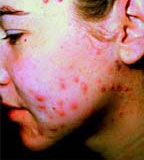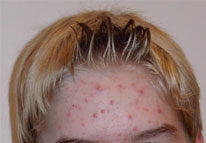


What is acne? What are the different types of acne
Acne vulgaris (commonly called acne) is a common human skin disease, characterized by areas of skin with multiple noninflammatory follicular papules or comedones and by inflammatory papules, pustules, and nodules in its more severe forms.
Acne vulgaris mostly affects the areas of skin with the densest population of sebaceous follicles; these areas include the face, the upper part of the chest, and the back. Severe acne is inflammatory, but acne can also manifest in noninflammatory forms
Acne (acne vulgaris, common acne) is not just a problem for teenagers; it can affect people from ages 10 through 40. It is not unusual for women, in particular, to develop acne in their mid- to late-20s, even if they have not had breakouts in years (or ever). On the positive side, those few individuals who have acne into their 40s may well grow out of it. Acne can appear on the skin as any of the following:
Acne vulgaris mostly affects the areas of skin with the densest population of sebaceous follicles; these areas include the face, the upper part of the chest, and the back. Severe acne is inflammatory, but acne can also manifest in noninflammatory forms
Acne (acne vulgaris, common acne) is not just a problem for teenagers; it can affect people from ages 10 through 40. It is not unusual for women, in particular, to develop acne in their mid- to late-20s, even if they have not had breakouts in years (or ever). On the positive side, those few individuals who have acne into their 40s may well grow out of it. Acne can appear on the skin as any of the following:
- congested pores ("comedones"),
- whiteheads,
- blackheads,
- pimples ("zits"),
- pustules, or
- Cysts (deep pimples, boils). The pus in pustules and cysts is sterile and does not actually contain infectious bacteria.
What causes Acne
Top
Acne develops as a result of blockages in follicles. Hyperkeratinization and formation of a plug of keratin and sebum (a microcomedo) is the earliest change, No one factor causes acne. Acne happens when oil (sebaceous) glands come to life around puberty, stimulated by male hormones from the adrenal glands of both boys and girls. Sebum (oil) is a natural substance which lubricates and protects the skin, and under certain circumstances, cells that are close to the surface block the openings of sebaceous glands and cause a buildup of oil underneath. This oil stimulates bacteria (which live on everyone's skin and generally cause no problems) to multiply and cause surrounding tissues to become inflamed.
Here are some factors that don't usually cause acne, at least by themselves:


Here are some factors that don't usually cause acne, at least by themselves:
- Heredity
- Food
- Dirt:
- Stress
- Hormones
- Cosmetics
- Pressure
- Drugs
- Occupations:


Scars
Top
Acne often leaves small scars where the skin gets a "volcanic" shape.
Physical acne scars are often referred to as "Icepick" scars. This is because the scars tend to cause an indentation in the skin's surface. There are a range of treatments available. Although quite rare, the medical condition Atrophia Maculosa Varioliformis Cutis also results in "acne like" depressed scars on the face.
Physical acne scars are often referred to as "Icepick" scars. This is because the scars tend to cause an indentation in the skin's surface. There are a range of treatments available. Although quite rare, the medical condition Atrophia Maculosa Varioliformis Cutis also results in "acne like" depressed scars on the face.
- Ice pick scars: Deep pits, which are the most common and a classic sign of acne scarring.
- Box car scars: Angular scars that usually occur on the temple and cheeks, and can be either superficial or deep, these are similar to chickenpox scars.
- Rolling scars: Scars that give the skin a wave-like appearance.
- Hypertrophic scars: Thickened, or keloid scars
What is the role of Homoeopathy in Acne?
Top
As described in the article above Acne has multifactor ail causes. Homoeopathy follows an individualistic approach towards patients suffering from acne we believe that every individual is different and thus a full in-depth case study is the first step. Then referring to the risk factors the individual was subjected too, a particular line of treatment is adopted. The usual conventional treatment provides only mere palliation or suppression. On the other hand our deep acting constitutional medicine cure the disease in depth rendering the patient free from the disease
A broad criterion of how the homoeopathic medicines act in cases of acne is mentioned below. The response to treatment can differ from one individual to another patients are advised to consult so that the mode of treatment can be discussed pertaining to their particular case
Relieves Symptoms like:
Our deep acting constitutional medicines work at the root level. Homoeopathy with its natural medicinal substances used in small quantities cures acne inside out. Also it helps cure the predisposition of skin to have acne.
If homoeopathic treatment is sought early it helps in preventing the progress of disease and preventing any complications (scars) from occurring, which are usually associated with the disease
We at DRSS provide our patients with diet charts, exercise schedules and guide them how to modify their lifestyle so that better results can be achieved.
Homoeopathic medicines if taken under proper guidance from a well-qualified professional are extremely safe and have no side effects.
Relieves Symptoms like:
- Itching
- Skin lesions
- Dryness of skin
- Tenderness
- Removes scars and marks caused by acne
Our deep acting constitutional medicines work at the root level. Homoeopathy with its natural medicinal substances used in small quantities cures acne inside out. Also it helps cure the predisposition of skin to have acne.
If homoeopathic treatment is sought early it helps in preventing the progress of disease and preventing any complications (scars) from occurring, which are usually associated with the disease
We at DRSS provide our patients with diet charts, exercise schedules and guide them how to modify their lifestyle so that better results can be achieved.
Homoeopathic medicines if taken under proper guidance from a well-qualified professional are extremely safe and have no side effects.

Acne




